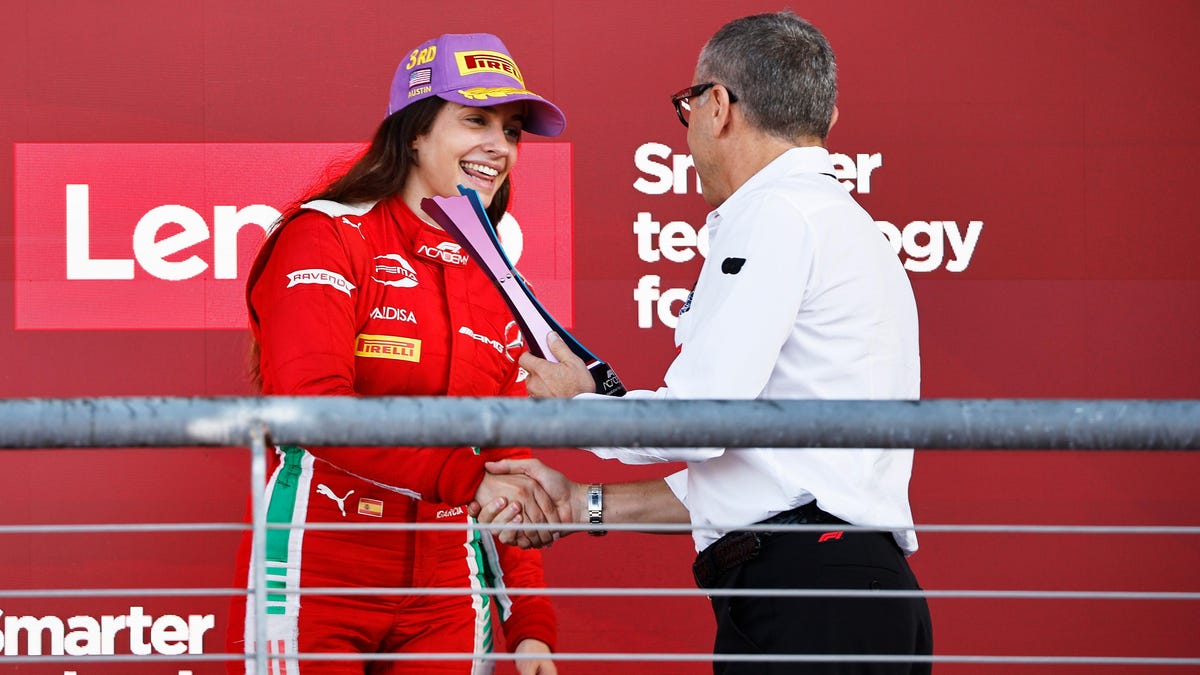Things have never looked better for women in motorsport. F1 Academy champion Marta García has secured a fully-funded ride with Prema in the Formula Regional European Championship by Alpine (FRECA) — and the series has promised to fully pay for any entries contested by the top-three finishers in the series. Formula 1 teams are getting deeply involved with F1A for 2024 and have already started signing drivers to their development programs, while racing-focused companies like Tatuus and Pirelli have donated enough money to lower the cost of entry for F1A entrants from $142,000 to $95,000. After last year’s painful demise of the other all-woman open-wheel championship, W Series, it’s promising to see a different series succeed where its predecessor failed.
While I hesitate to pit women against one another, a friend of mine summed up the difference between W Series and F1 Academy perfectly during the U.S Grand Prix weekend: “W Series ran so F1 Academy could walk.”
W Series was a radical, incredible idea that was launched into fruition outside of F1’s direct oversight and perhaps with more lofty goals than strategy; as a result, the drivers competed in races, but it felt like women racing against one another was the entire purpose, as the prizes were fairly minimal. By contrast, F1 Academy saw a slow growth throughout its recently completed first season. Because it’s a product of Formula 1, it has benefitted from decades of knowledge on how to best run a series, and once it proved itself, F1 Academy was loaded with strong prizes to reward competition.
Of course, W Series didn’t fail for lack of trying; instead, it fell victim to its own desire to do too much too soon. It simultaneously attempted to revitalize the careers of older and more experienced women drivers while also attempting to be a starting point for younger teenagers just starting out. It provided a substantial cash prize to the championship winner but no guarantees that the winner would actually progress beyond W Series — hence why it was dominated by Jamie Chadwick for all three years of its existence; multiple insiders I spoke to told me that Chadwick’s prize money was never enough to secure her a seat in a mixed-gender championship, and so she remained in W Series hoping to gain more money.
Prior to F1A’s season finale at Circuit of the Americas, I spoke with Bianca Bustamante, an 18-year-old Filipina racer competing with Prema and who also contested the 2022 W Series championship. She was able to provide context about where she felt F1A stood compared to W Series.
“The [F1A] grid consists of younger generations, like myself and my teammate Chloe Chong; she’s only 16,” Bustamante said. “It’s not like W Series, where we were racing against drivers who were late 20s and above. In F1 Academy, everyone is more compact in age.”
She continued, saying, “In W Series, I was one of the youngest on the grid. I went straight from karting to a Formula 3 car, and my head was blown from all the information. Every race weekend we came to, we didn’t have testing prior to the event. It was always my first time [at the track], and we had 30 minutes to learn it.
“In F1 Academy, we’re given 15 days of testing [before the season]. We’re given practice before the race, then two qualifying [sessions] and three races — all chances to better ourselves.”
Of course, more track time is always better for a variety of reasons, but for a younger driver like Bustamante getting behind the wheel of a Formula series machine for the first time, the biggest fear was failing.
“When you have more time in the car, you allow yourself to make more mistakes and learn from it. You’re able to risk more,” Bustamante said. “With W Series, I wasn’t given the track time. Therefore I was always scared to crash the car, to make a mistake, to spin out.”
Increased testing time, a smaller spread of ages — the oldest driver in F1A this season was Léna Bühler, who turned 26 in July — and a less challenging car have all enabled F1A racers an opportunity to grow an develop a comprehensive set of skills, as opposed to W Series, which seemed to intend to do that but was set up in such a way that favored the more experienced racers.
I’ll admit that I was deeply skeptical of F1A when it was announced; a lack of details about the championship seemed ominous, as did F1’s lack of support for W Series. But as 2023 progressed, F1A has grown rapidly as more talented individuals were hired to work behind the scenes while F1 teams like McLaren have signed F1A drivers like Bustamante to their young-driver programs. That alone would have been enough to justify F1A as a success, but the promise for the future is already incredibly great.
Heading into 2024, F1A will feature 15 teams — 10 of which will be fielded by current F1 teams in an effort to funnel more female talent into their pipelines. The other five teams are yet to be announced, but they will likely include feeder series teams like Prema, Carlin, or ART. Support from Pirelli, Tatuus, and Prema means that these young women will have to front less money to be able to compete — and their performance can be directly rewarded with a seat in a feeder series that will provide them with the funding to compete at the next level. That’s a level of promise W Series struggled to provide — but W Series also developed the template upon which F1A could be built. As my friend said, W Series really did run so F1A could walk.

